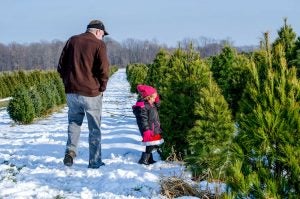Just days after ringing in the new year, Christmas tree farmers are already preparing your trees for the next Christmas. Too soon? Actually, we should’ve started earlier.
According to the National Christmas Tree Association, the average growth period of a Christmas tree is around seven years, so one could say Christmas tree farmers are way ahead of their time. When one season ends, a tree farm is already on track for at least 10 years in advance. Call us forward thinkers, dreamers, or hashtag goals, but definitely don’t call us lazy for making our money to operate an entire year in only two months. Those two months are nothing short of busy — from wholesale harvest to retail cut and carry, our plates are full. After Christmas, tree farms sometimes slowly creep into a hibernation state until November of the following year, but that doesn’t mean preparations aren’t taking place year round.
After Christmas, we regroup. Fields are restored to normal order, roads are fixed from the winter elements, the seedling orders are placed, and the lineup is completed for spring planting. One would think that after Christmas, tree farms shut down until next year, but in reality the farm will be beaming with life all year long. The trees are replanted yearly, but a tree doesn’t always grow perfectly without a little help. Most trees in their lifetime will be sheared close to twenty times — that’s at least twice a year. Of course, there’s spraying and pest management that takes place as the weather allows, but the real work comes in the form of patience.
Our patience comes in the form of waiting on trees to grow, but also waiting on another season to roll around. The life of a Christmas tree farmer, to those looking in, looks like a Hallmark movie, but it’s actually quite the opposite. As a quickly dying agricultural practice, Christmas tree farms are becoming few and far between, so the art form is slowly becoming a rarity.

With the primary source of income on a Christmas tree farm coming in only two months a year, making ends meet can be a struggle. Diversity is necessary, rather than optional. Many Christmas tree farmers expand into pumpkins, corn mazes, etc., while some of us are in the cattle business as well.
Many may think after Christmas our work is done, but the truth is it is just beginning. Maybe we are wrangled back into reality, or maybe we keep moving forward, but just after closing for the season, we find ourselves kind of at a loss of what to do next. We go back to our everyday schedules, and back to the caring of the trees before they are cut next year.
While it may look as though Christmas tree farms take a deep sleep in the dead of winter, rest assured they are not. They are alive and well, as thousands of Christmas trees never sleep.
Callie Taylor is a twenty-something West Virginia native content creator and digital strategist changing the face of brands in the agriculture and food space.


